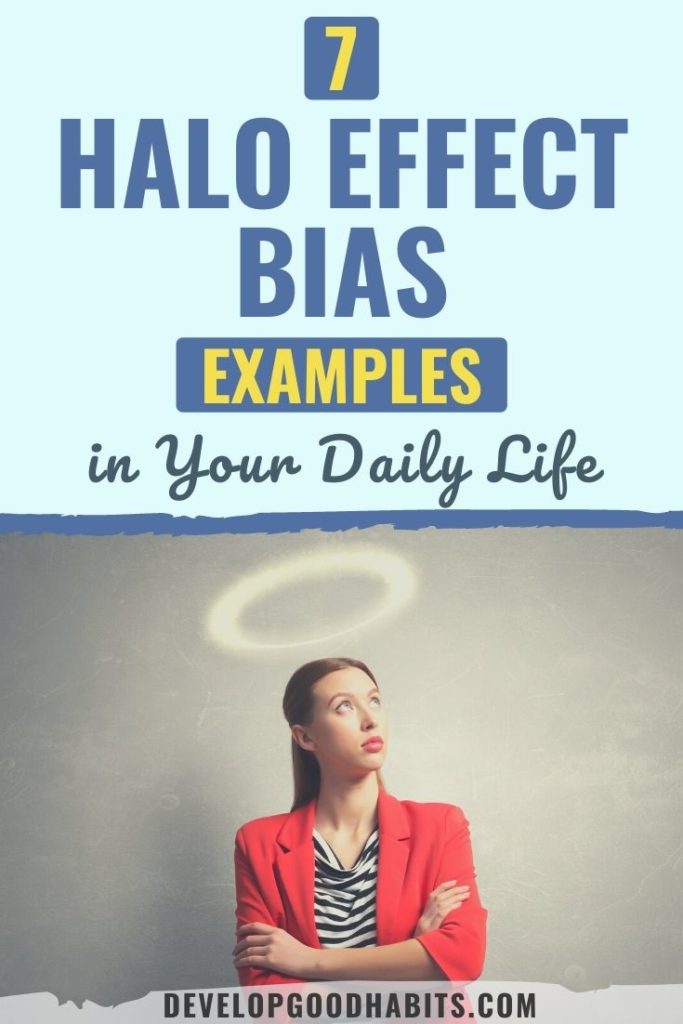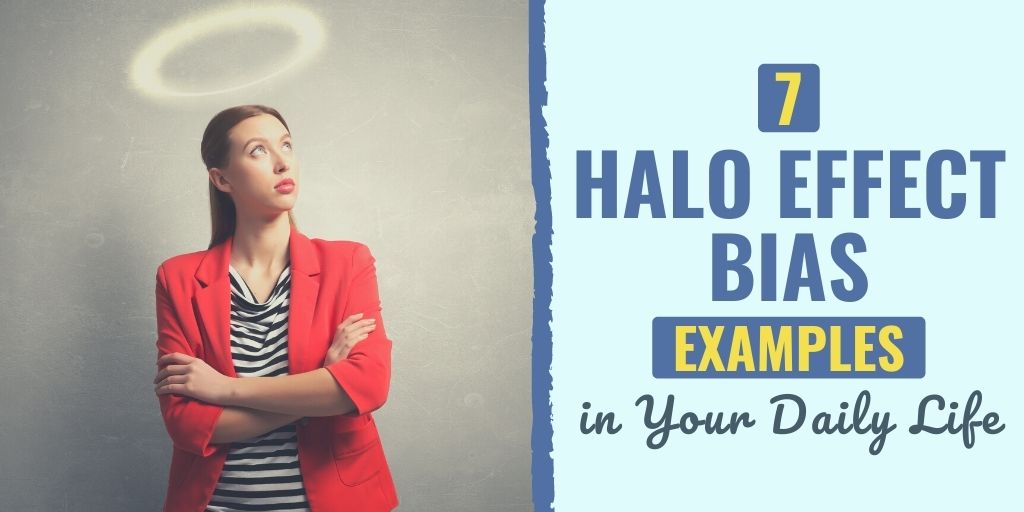There might be affiliate links on this page, which means we get a small commission of anything you buy. As an Amazon Associate we earn from qualifying purchases. Please do your own research before making any online purchase.
What was your first impression of your current best friend? What about your partner? Your boss? Did these initial assumptions end up being spot on?
Maybe, but I know several people whose first impressions of the person they ended up marrying was NOT one that had them imagining the future. But others, the moment they laid eyes on their future spouse, that person could do no wrong.
We have talked about first impressions before and why it’s important to make a positive one–they last! And in this article, we are going to talk about a cognitive bias that is strongly related to the idea that you can’t always judge a book by its cover.
This bias is called the halo effect, and it’s important to understand because it's common and can impact the way you perceive other people and how they perceive you. After we look a little more at what this cognitive bias is, we will go over seven examples of the halo effect that you may come across in your everyday life and what you can do to counteract its influence.
Let’s get started.
What Is the Halo Effect Bias?
American psychologist, Edward Thorndike, coined the term “halo effect” in his 1920 research, A constant error in psychological ratings. Thorndike studied the behaviors of military officers as he asked them to classify their subordinates according to their leadership skills and intelligence before being able to communicate with them.
Thorndike’s findings showed that the officers’ assumptions regarding character traits were greatly influenced by the unrelated physical traits of those they were judging. Thorndike concluded that people’s impression of someone else’s overall character is greatly determined by that person’s physical appearance. This phenomenon is called the halo effect bias, and it specifically defines when one characteristic has a positive correlation on the rest, such as assuming someone who is attractive is also smart and successful.
So, why do we make these snap judgments? Our brains are wired to work efficiently so we can respond to our surroundings, but sometimes this leads to cognitive errors that go unrecognized and eventually lead to biases. Research has consistently revealed that our brains can unconsciously make a judgment before we even realize we’re thinking about something.
What’s more, neuroscientists at MIT have found that the human brain can make a judgment of an image that it has been exposed to for only 13 milliseconds. After reviewing brain scans of those who were shown a person’s picture for such a short amount of time, the researchers found that the participants’ amygdala became active right away, making a determination whether or not the face seemed trustworthy. These instantaneous results were in line with respondents who took the time to study a face before deciding if the person could be trusted.
This just goes to show that our brains go through processes without us even realizing it, and even with the best of intentions, your decisions may still be influenced by bias.
The Problem with the Halo Effect Bias
The assumptions that people make with little information to go off of are subjective, which can prevent someone from looking at someone or something comprehensively before making a judgment. This can cause people to make mistakes in their judgments and overlook potentially beneficial opportunities.
In social situations, we make assumptions about other people based on the things that we know are true. We then fill in the blanks with characteristics that “make sense” with our past experiences. So, while it may sound surprising that we make assumptions about someone’s character just by looking at them, it’s just our brains’ way of constructing a truth that aligns with the information we have. But, yes, this can lead to mistakes.
Let’s take a look at some examples of the halo effect bias that may sound familiar to you.
7 Halo Effect Bias Examples in Your Daily Life
1. In Medicine
Imagine being a doctor and having to combat your first impression of someone when making a medical diagnosis or prescribing drugs. Amidst our current opioid epidemic, would you treat someone who was complaining of pain in a certain way depending on how they initially presented themselves?
Or what if you were a mental health professional? Would you be biased when making a diagnosis if someone didn’t “look the part”?
Studies have found that being attractive may cause people to be at a disadvantage when having a medical checkup. Doctors may associate someone who is attractive as someone who is healthy and refrain from asking questions that could lead to critical information that suggests otherwise, such as mental health disorders or some “invisible” illnesses. But, without having the proper conversations and testing, these health maladies often go undetected.
2. Personal Relationships
Thinking about the personal relationships you have, you may recognize that the halo effect bias has played a role in some of them. When we meet new people, we usually know some concrete information about them (like their profession, their hometown, their appearance, their likeability, etc.). From there, we fill in the gaps using this immediate judgment practice to complete our initial assessment of the other person.
Can you think of a time that you’ve assumed something about someone based on other information you knew, and then you were completely taken by surprise when you found out something new about them?
I remember being surprised a few years ago when I was working for a company and I assumed by the way the CEO presented himself that he lived this lavish lifestyle with luxury accommodations. When I saw him drive up to work one day in his modest (and aged) vehicle, I stood corrected as I realized I had made a snap judgment and filled in the blanks about this person without having any objective knowledge.
Assuming you have a complete evaluation of someone with only a handful of hard truths can impact your perception of someone’s choices, ideas, and associations because the concrete data you have can influence your determination of uncertain information.
3. In Politics
Research has found that the halo effect has an impact on votes in political elections as well. The halo effect tends to lead people to equate someone’s ability to be a leader with their facial appearance and attractiveness. In the study, participants were asked to make one-second judgements of side-by-side pictures of two political candidates’ appearances. The candidates that the subjects found to be more attractive ended up significantly aligning with election outcomes.
Another study shows that, more specifically, the impact that beauty evaluations have on electoral votes emerges as a more significant predictor with voters who have a lower level of political competence. In other words, those who know very little about candidates aside from their appearance are most likely to develop their political outlook based on whether or not a nominee is attractive.
4. Hiring Employees
Consider how one job candidate may become favored over another because of the halo effect. While this may not have a big impact on an organization if it happens once or twice, if one personal characteristic is always valued above all else, it could decrease diversity in a team and end up being detrimental, as qualified candidates are being passed over.
Once hired, the halo effect may still play a factor in ineffective professional collaborations. Can you think of an employee you’ve worked with at some point who had one particular trait or benefit that allowed them to be held to a more lenient standard than the rest? For example, someone who is regularly the top sales person on a team easily getting away with slipping out at noon on Fridays or turning work in late while others get penalized for it. What about if that person’s performance isn’t necessarily the best, but they’re related to the decision maker?
People can more easily overlook problems when there is a positive characteristic shining over someone and putting everything else in the shadows. While this alone is a problem, it can also cause other employees to be resentful if they’re unfairly held to those higher standards.
5. Spokespeople
Companies use the halo effect in their marketing strategies to sell products by featuring popular spokespeople on their ads. If people see that a celebrity endorses a product, they’re likely to believe the product is credible right away, and they will buy the product just because they heard the celebrity tell them to do so. This is because people admire celebrities so much, and many grow up believing they should be like the people they see on television.

Studies have shown that sales increase by an average of 4% when companies have a celebrity endorse their products. The key is to find the right person who the company’s target demographic will recognize.
Market professionals do research to see who the most relevant celebrities are at the moment for their potential customers and try to get a celebrity who fits the profile. This way, they can lure in customers who look up to the celebrity who is “using” the product.
6. Marketing
The halo effect is used in marketing to build customer bias toward particular brands because of one positive experience with a product the company manufactured. The halo effect comes in when the features of the first product that were favorable grow into a larger brand of products through the creation of a line extension. Extending a product’s line is less risky than developing an entirely new product because there is already a market in place waiting for this new flavor, color, scent, or style to be released.
Line extensions add variety to an existing product to give its current customers some new options and to reach a larger customer base. Think about drinking the same soda for years and loving it. But then, the company releases a “diet” option. Subsequently, they offer a cherry-flavored option or one with a hint of vanilla. If you love the original product, you will probably assume that these slight variations are just as great.
Similarly, companies often feature buzzwords on their products, such as “organic”, “keto-friendly”, or “dairy-free”. Products with labels such as these may be perceived by shoppers as being healthier overall than their counterparts who don’t make these associations with their products, when in reality, the overall health of a product may not be impacted by its “organic” nature (or whatever feature is highlighted).
7. In Education
The halo effect bias has even been known to impact students’ outcomes in school. One study that looked at how the halo effect bias could potentially limit students’ future performance found that students who were seen as being more attractive were also perceived to be harder workers than students who gave a less attractive first impression. And, those who were perceived as being harder workers ended up receiving better grades than those who were less conscientious.
Similar to others, the findings of this study demonstrate how positive first impressions can be misleading when judging someone’s competence, which can have serious implications on one’s future.
How to Counter the Halo Effect Bias
To reduce the likelihood that your decisions are being impacted by this cognitive bias, you can try a few cognitive debiasing tricks, like taking the time to go through a reasoning process or making sure to always play devil’s advocate with yourself.
Try to be conscientious when making evaluations of people or things. If you get lazy and rely on your instincts, your brain is likely to take shortcuts. Take time to process information so you’re able to consider alternatives before jumping to conclusions.
Final Thoughts on the Halo Effect Bias
The halo effect bias can clearly distort our perception of someone’s advice or “expertise”. This means that if we have a good impression about someone, we’ll probably overrate their advice, even if it’s not good advice. Alternatively, with a negative feeling about someone, we may ignore good advice.
It’s tough to completely disregard our biases. We are emotional beings and often act on our feelings. But if you take the time to stop and reflect on your decisions, you may find that the halo effect is negatively impacting your otherwise sound judgment, and leading to poor decision-making.
Being aware of the halo effect can help you recognize how and when it may affect your life. Whether you’re voting for president, hiring an employee, or buying a product at the grocery store, you should consider how your decision-making may have been impacted by your evaluation of irrelevant characteristics. And, while being aware of the halo effect may not erase all personal bias, it can help you use your critical thinking skills to make more objective decisions.
Learn More About Logical Fallacies
If you want to expand your knowledge about the different logical fallacies and learn how to avoid them, check out our other posts:
- 15 Cognitive Biases: A List of Common Biases Many People Have
- 5 Appeal to Nature Fallacy Examples in Media and Life
- 6 Outcome Bias Examples That Can Negatively Impact Your Decisions
- 7 Self-Serving Bias Examples You See Throughout Life
- 7 Omission Bias Examples That Negatively Impact Your Life
- 6 Authority Bias Examples That Might Impact Your Decisions
- 5 Burden of Proof Fallacy Examples
- 5 Appeal to Tradition Fallacy Examples in Life
- 5 Appeal to Authority Logical Fallacy Examples
- 7 False Cause Fallacy Examples
- 7 Appeal to Ignorance Fallacy Examples
- 7 Appeal to Common Sense Logical Fallacy Examples
- 5 Post Hoc Fallacy Examples (and How to Respond to This Argument)
- Gambler’s Fallacy: 5 Examples and How to Avoid It
- 5 Appeal to Anger Fallacy Examples Throughout Life
- 7 Poisoning the Well Examples Throughout Your Life
- 7 Survivorship Bias Examples You See in the Real World
- 7 Dunning Kruger Effect Examples in Your Life
- 7 Either Or (“False Dilemma”) Fallacy Examples in Real Life
- 5 Cui Bono Fallacy Examples to Find Out “Who Will Benefit”
- 6 Anchoring Bias Examples That Impact Your Decisions
- 7 Virtue Signaling Examples in Everyday Life
- 7 Cherry Picking Fallacy Examples for When People Ignore Evidence
- 9 Circular Reasoning Examples (or “Begging the Question”) in Everyday Life
- 9 Appeal to Emotion Logical Fallacy Examples
- 9 Appeal to Pity Fallacy (“Ad Misericordiam”) Examples in Everyday Life
- 9 Loaded Question Fallacy Examples in Life and Media
- 9 Confirmation Bias Fallacy Examples In Everyday Life
- 9 Bandwagon Fallacy Examples to Prevent Poor Decisions
- 5 Red Herring Fallacy Examples to Fight Irrelevant Information
- 9 Middle Ground Fallacy Examples to Spot During an Argument
- 5 False Equivalence Examples to Know Before Your Next Argument
- 7 Hasty Generalization Fallacy Examples & How to Respond to Them
- 6 Straw Man Fallacy Examples & How You Can Respond
- 6 False Dichotomy Examples & How to Counter Them
- 7 Slippery Slope Fallacy Examples (And How to Counter Them)
- What is the Planning Fallacy?
- How to Overcome the “Sunk Cost Fallacy” Mindset
Finally, if you want a simple process to counter the logical fallacies and cognitive biases you encounter in life, then follow this 7-step process to develop the critical thinking skills habit.

Connie Mathers is a professional editor and freelance writer. She holds a Bachelor's Degree in Marketing and a Master’s Degree in Social Work. When she is not writing, Connie is either spending time with her daughter and two dogs, running, or working at her full-time job as a social worker in Richmond, VA.


